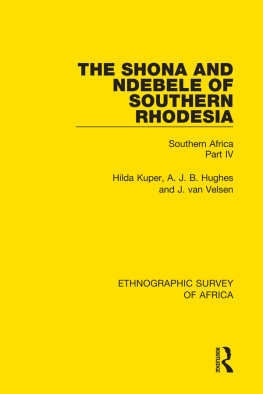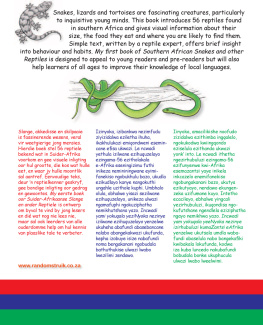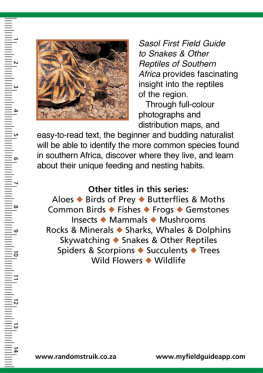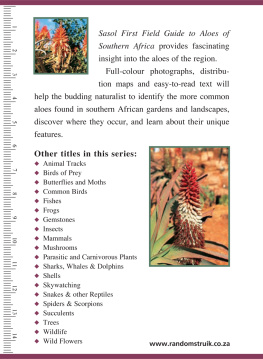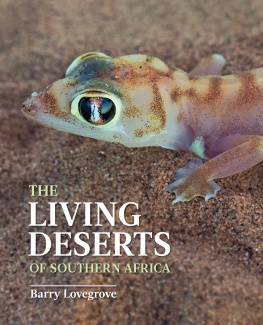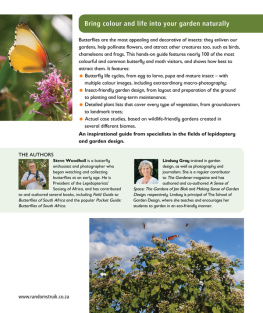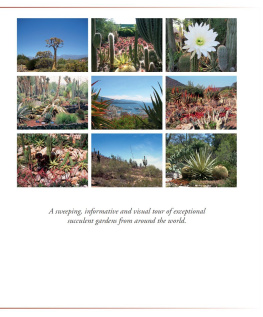ALOES
IN SOUTHERN AFRICA
Gideon F. Smith
Braam van Wyk
Struik Nature
(an imprint of Random House Struik (Pty) Ltd)
Reg. No. 1966/003153/07
Wembley Square, First Floor, Solan Road, Cape Town, 8001
PO Box 1144, Cape Town, 8000 South Africa
Visit us at www.randomstruik.co.za
and subscribe to our newsletter for monthly updates and news
This ebook edition published in 2011
First published in print in 2008
Second impression 2009
Copyright in published edition, 2008, 2011: Random House Struik (Pty) Ltd
Copyright in text, 2008, 2011: Gideon F. Smith and Braam van Wyk
Copyright in photographs, 2008, 2011: G.F. Smith except for pages 126, 128, 129, B. van Wyk; page 44, J.P. Roux.
Copyright in illustrations, 2008, 2011: G.F. Smith
Copyright in maps, 2008, 2011: page 9, G.F. Smith and R.R. Klopper; page 55, B. van Wyk and G.F. Smith
Publishing manager: Pippa Parker
Managing editor: Helen de Villiers
Designer: Janice Evans
Editor: Gill Gordon
Illustrator: Jaco van Wyk
Cartographer: Martin Endemann
All rights reserved. No part of this publication may be reproduced, stored in a retrieval system, or transmitted, in any form or by any means, electronic, mechanical, photocopying, recording or otherwise, without prior written permission of the copyright owner(s).
ISBN 978 1 77007 462 0 (Print)
ISBN 978 1 92054 444 7 (Epub)
ISBN 978 1 92054 445 4 (PDF)
:Aloe excelsa
:Aloe arborescens x Aloe ferox
The genus Aloe displays a wide diversity of different growth forms. However, for most people Aloe marlothii, here towering over most of the surrounding plants, represents the archetypal aloe.
PREFACE
In this book we present selected aspects of the intriguing biology of members of the genus Aloe in Africa and beyond. Commonly known as aloes, we describe and illustrate how they function at both the individual and environmental levels. We also refer to some of their closest and more distant relatives. The intention is to satisfy the curiosity of both the amateur and professional biologist by telling the stories behind these fascinating species and their kin. We deliberately also refer to other representatives that are included in the family of Aloe relatives (rather than the Aloe family). But this book is predominantly about aloes; stately, sometimes miniature, succulent plants that vividly define the landscapes in which they occur perhaps the ultimate group of African flagship plants. We also discuss a number of the most common species likely to be encountered in South Africa.
Once equipped with knowledge about aloes, the urge to grow them successfully becomes all-consuming. One of the main reasons is because gardening with succulents in general, but aloes in particular, allows the gardener to break free from the chore of seasonally replacing thick drifts of annuals planted in a neatly raked bed. The predominantly chilli-red and vibrant orange hues of aloe flowers contrast with the verdant greens of their sword-shaped leaves and the surrounding plants. This combination creates a peaceful, calming unity in the garden. In a rockery, or any garden for that matter, shrubby, tree-like aloes form an impressive backbone.
Aloes respond positively to the vernacular African landscape its prevalent climate and the earthy, roughshod hardscaping accessories created from local materials, like natural rocks and pieces of wood. These sturdy plants embody the creative allure of the African savanna (bushveld) and karroid landscapes, and the satisfaction that comes from creating a natural, indigenous garden. Part of the book is dedicated to the cultivation and propagation of aloes, and numerous tips are given on how to make the most of these plants in human-made environments. Finally, we look at the many uses of aloes today, from contemporary and traditional medicinal preparations to their use in cosmetics, foodstuffs and in the rural environment.
To the team at Struik who worked with us in creating the book Pippa Parker, editors Helen de Villiers and Gill Gordon, and Janice Evans who designed the book we extend our grateful thanks.
Gideon F. Smith &
Braam van Wyk
PRETORIA, 2008
PART ONE
ALOES AND THEIR KIN
A form of Aloe arborescens with light green leaves and bright orange inflorescences. Taken in the Pretoria National Botanical Garden of the South African National Biodiversity Institute.
INTRODUCING ALOES
Stem succulents often cohabit in the same habitats where Aloe species and other succulents occur. Adansonia digitata, the baobab, has large, chunky but soft stems that resemble lumps of molten candle wax.
Apart from the massive baobab tree (Adansonia digitata), the worlds largest succulent plant, aloes are certainly among the most familiar of all the conspicuous tall-growing succulents that inhabit the worlds arid, and sometimes not so arid, regions. But in contrast to the baobab, aloes are far more diverse and occur over a much broader range of climates and habitats. Wherever the intrepid traveller through Africa may wander, there are sure to be aloes in the landscape. Not all are tall, robust and tree-like; some are small and dainty, and some may hide among rocks or under bushes. Others, perhaps the majority, are medium-sized and can be more accurately described as bulky, thigh-high plants with thick, juicy, persistent and durable leaves congested, often in rosettes, at the tips of branched or unbranched stems.
Aloe and aalwyn are the names commonly used for members of the genus Aloe in the family Aloaceae. The Afrikaans name aalwyn, often used with the prefix klein- (small), is applied to aloe relatives, most of which have the appearance of aloes. This family embraces not only the genus Aloe, but a number of other genera too, which are discussed in more detail on . As succulent plants, aloes are able to absorb water and store it in the fleshy tissues of their leaves or roots, drawing on it to sustain themselves through dry periods. Aloes are perennial, or polycarpic plants, capable of living for many years and, once mature, of flowering annually.
Today, much of the African interior experiences low precipitation and consequent aridity. Aloes, and other plants found here, have had to adopt strategies that enable them to survive the environmentally hostile conditions. The remarkable diversity of plants found in these parts suggests that large numbers of them have adapted perfectly and not only survive, but flourish in the harsh conditions. The arid parts of southern Africa are host to the largest and richest diversity of succulent plants in the world: an astounding 4 674 plant species, classified in 58 families, show some form of succulence. This means that nearly 47 per cent of the worlds succulents grow in southern Africa.


